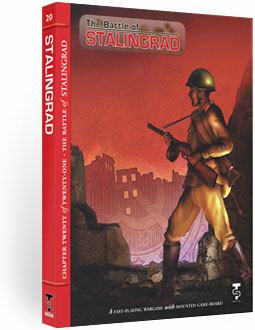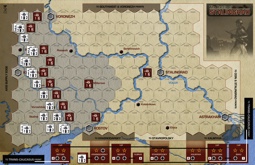The Stalingrad CampaignPivot on the VolgaOut of all the most horrific battles of WWII, one name stands out above the rest: Stalingrad. It became the focus point for everything else on the Eastern Front. Once they battled into the city, the German troops called it the "Rattenkrieg," the "rat’s war," and joked that they had "captured the kitchen but were still fighting for the living room." The joke had more than an element of truth, as the bitter fighting went from block to block, then building to building, and - literally - room to room. Soviet soldiers in the city said, "There is no land on the other side of the Volga." Stalingrad was the living example of the Unstop- pable Force meeting the Immovable Object, as "Advance at all costs!" orders from Hitler ran into "Not a step back!" orders from Stalin. And then came Operation Uranus, when Hitler and Stalin reversed those same orders. But the battle for Stalingrad-the-city was only part of the German 1942 campaign, with its multiple priorities of political objectives (like Stalingrad) and resource objectives (like the Caucasus). Now, you can face the same questions and try to do better.
Now, you can revisit one of the most bitter cam- paigns of the war, in a challenging game you can play in a single sitting. The Stalingrad Campaign puts you in charge where a whole region is aflame, leading up to the bitter fight- ing in the city and what was a true turning point of the entire war. The choices are up to you! Capturing Operational DifferencesThe Stalingrad Campaign manages to provide monster game nuances in a game small in size with innovative design. For example, the sequence of play is not the same for each side. And why should it be? The Axis and Soviet armies do not do the same tasks each turn, because their armies operated differently.
Operation Uranus, the great Soviet counter- offensive, has optional start times, with incentives for delay (if the rest of the Soviet front can hold out!). Sudden death victory is possible for both sides, encouraging that extra effort that could win it all...or leave one exposed and exhausted. At the end of the game, key point adjustments and multipliers get factored in and compared. Short of the Sudden Death victory, which side really "wins" can be in doubt to the very end. As it should be, in a situation like this.
The Stalingrad Campaign:Map: Full color, 11” x 17” mounted mapboard with integrated strategic movement trackPieces: 216 full color, 9/16" die-cut counters Rulesbook: 12 pages Charts and Displays: Six player aid charts Skill Level: Advanced Designer: Hjalmar Gerber Part of the TPS, "Decisive Battles" seriesThat means straightforward rules, key insights into the history behind the game, and designs aimed at one-session conclusions and high replay value. With shifting objectives and variable entry times for key units, no two Stalingrad games will play the same. |
Download the latest rules in PDF format Email us your questions and comments Download the updated German Armor card Visit our game support folder on Consimworld About the Designer: The designer of this game is Hjalmar Gerber. He says "designing is fun. The real works is done by the developers, testers and proofreaders; and let us not forget the artist who makes a game look better than I can imagine it. " Hjalmar calls himself a “home secretary”, meaning that he is retired – after a career in information technology. “The days are still too short”, but he can always find time for voicing an opinion on political economics from an Austrian-school perspective. “There are so many books to read, games that are yet to be played, and so much good music in search of an ear.” See how the game plays |
|
View Cart
Go to Checkout
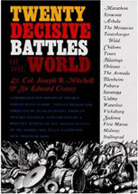 >
>In 1964, historian Lt. Col. Joseph B. Mitchell published a compact book, Twenty Decisive Battles of the World, an expansion of Sir Edward Creasy's most famous work from a hundred years past, updating it into the 20th Century.
Turning Point Simulations (TPS), a division of LPS Inc, examines these 20 battles with a new series of boxed wargames. These games emphasize accessibility and playability, and come with hard-mounted maps and mounted, die-cut counters. Each battle is presented in a design of low complexity, but high challenge, from some of the industry's top designers.
And be sure to check out our sister publication Against the Odds!
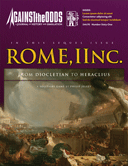
While TPS games focus on the decisive battles across time, Against the Odds magazine investigates all of military history from a broad perspective. The economic, political, religious and social aspects of warfare are examined in concert with events on the battlefield. Get yourself truly "connected" with games and gaming by subscribing to Against the Odds! Learn more...
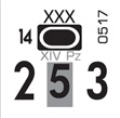 Each player will take the role of the operational theater commander. You still have leaders with short names and shorter tempers looking over your shoulder and telling you want to do (handled in game terms with directives and procedures that turn your decision making choices as much into "How do I please him?" as "How do I beat the enemy?") Counters represent mostly Soviet armies and German corps, with "assets" that can be attached to both, and minor Axis allies represented as well. Map scale is 55km to the hex, with 2 turns per month.
Each player will take the role of the operational theater commander. You still have leaders with short names and shorter tempers looking over your shoulder and telling you want to do (handled in game terms with directives and procedures that turn your decision making choices as much into "How do I please him?" as "How do I beat the enemy?") Counters represent mostly Soviet armies and German corps, with "assets" that can be attached to both, and minor Axis allies represented as well. Map scale is 55km to the hex, with 2 turns per month.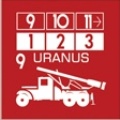 The Soviet player actually allocates supplies as he sees fit. Does he reward success or try to stave off defeat? Both players use Tactical and Strategic movement, as they move their forces around the battlefield. German Primary and Secondary objectives are determined randomly (and hidden from the Soviets!). Side operations in the Caucasus offer additional victory points but occupy units to achieve them. Are the points worth the cost?
The Soviet player actually allocates supplies as he sees fit. Does he reward success or try to stave off defeat? Both players use Tactical and Strategic movement, as they move their forces around the battlefield. German Primary and Secondary objectives are determined randomly (and hidden from the Soviets!). Side operations in the Caucasus offer additional victory points but occupy units to achieve them. Are the points worth the cost?
